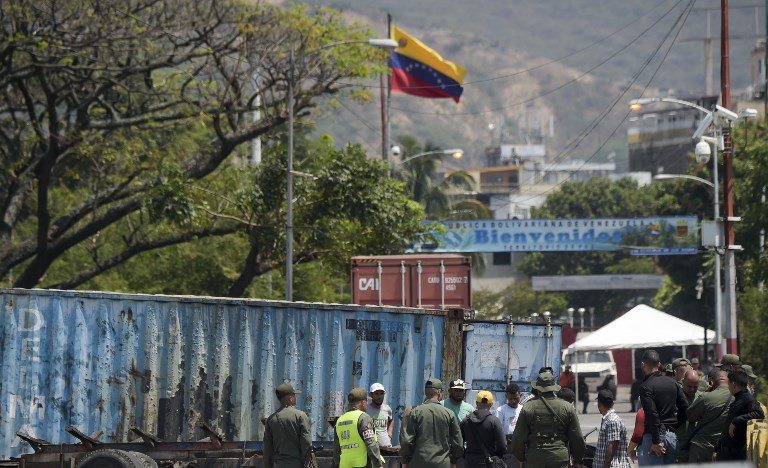
by Esteban ROJAS
Agence France Presse
UREÑA, Venezuela (AFP) — Bloody violence may have subsided for now at Venezuela’s blockaded border, but for local people, terror has turned to anxiety about how they will reach the schools and shops they depend on.
In the Venezuelan border town of Urena, Kelly Pinto stared at the Santander Bridge leading to Colombia — now blocked by a white armored truck.
Like many of her neighbors, she was wondering when it will reopen so she can reach the Colombian city of Cucuta.
“My youngest is really worried. She says, ‘Mummy, I want to go to school; mummy, I have an exam,” said Pinto, mother of two girls aged eight and 10.
“What am I supposed to do?” she said. “They won’t tell us whether they are going to open it or not.”
Nearby, a small group of schoolgirls stood with a sign that read, “We want to go to school. Let us pass.”
While her children go to a school across the border from their crisis-hit country, Kelly lives off trading in goods she buys on the far side of the bridge.
Thousands like her rely on crossing to Cucuta to get the basic goods and services lacking in Venezuela.
Blocked by debris
On the bridge, a white armored truck — known as a “bat” for the white metal wings that extend from its sides — sat blocking the way.
The border has been shut since clashes broke out on this and other nearby border crossings over the weekend.
Venezuelan security forces cracked down on opposition supporters trying to bring aid supplies across the bridge.
National Guards fired tear gas and rubber bullets. Demonstrators set fire to a bus.
Its charred remains were being towed out of the way on Tuesday, but other debris still lay around.
President Nicolas Maduro had branded the aid bid a ploy by his opponent, self-declared president Juan Guaido. Maduro said it was a pretext for a US invasion.
Awaiting orders
Colombia had said it would reopen the border crossings from Cucuta to Urena and nearby San Antonio early Tuesday.
But the decision depends equally on the Venezuelan military. The crossings were still blocked later in the day.
A group of local people timidly approached a detachment of soldiers guarding the Santander bridge, hoping to be allowed to cross.
The locals offered to help clear the rubble left over from Saturday’s disturbances.
The soldiers “told us they are in the process of opening it,” said one of the group of neighbors, Gladys Celis.
Her husband and eldest daughter work in Cucuta and her younger daughter goes to school there.
But the soldiers “gave no date, no time, nothing,” she added. “They are awaiting orders.”
Maduro’s authorities claimed a victory on Saturday after blocking Guaido’s side from trucking in the aid.
International bodies criticized the military for targeting those trying to bring in the aid trucks, one of which was set on fire.
Bad memories
Maduro’s government on Saturday shut down the country’s entire border with Brazil, where unrest left four people dead.
He also closed four border bridges to Colombia in the western state of Tachira.
The 2,200-kilometer (1,400-mile) border with Colombia had already been shut before, from 2015 to 2016, after an attack on a Venezuelan military patrol.
Since that peak of tension with Colombia, it had been reopening gradually for people’s work or medical needs until the latest upsurge of unrest.
But regional trade groups say only about a fifth of local trade has recovered from that earlier shutdown.
© Agence France-Presse







